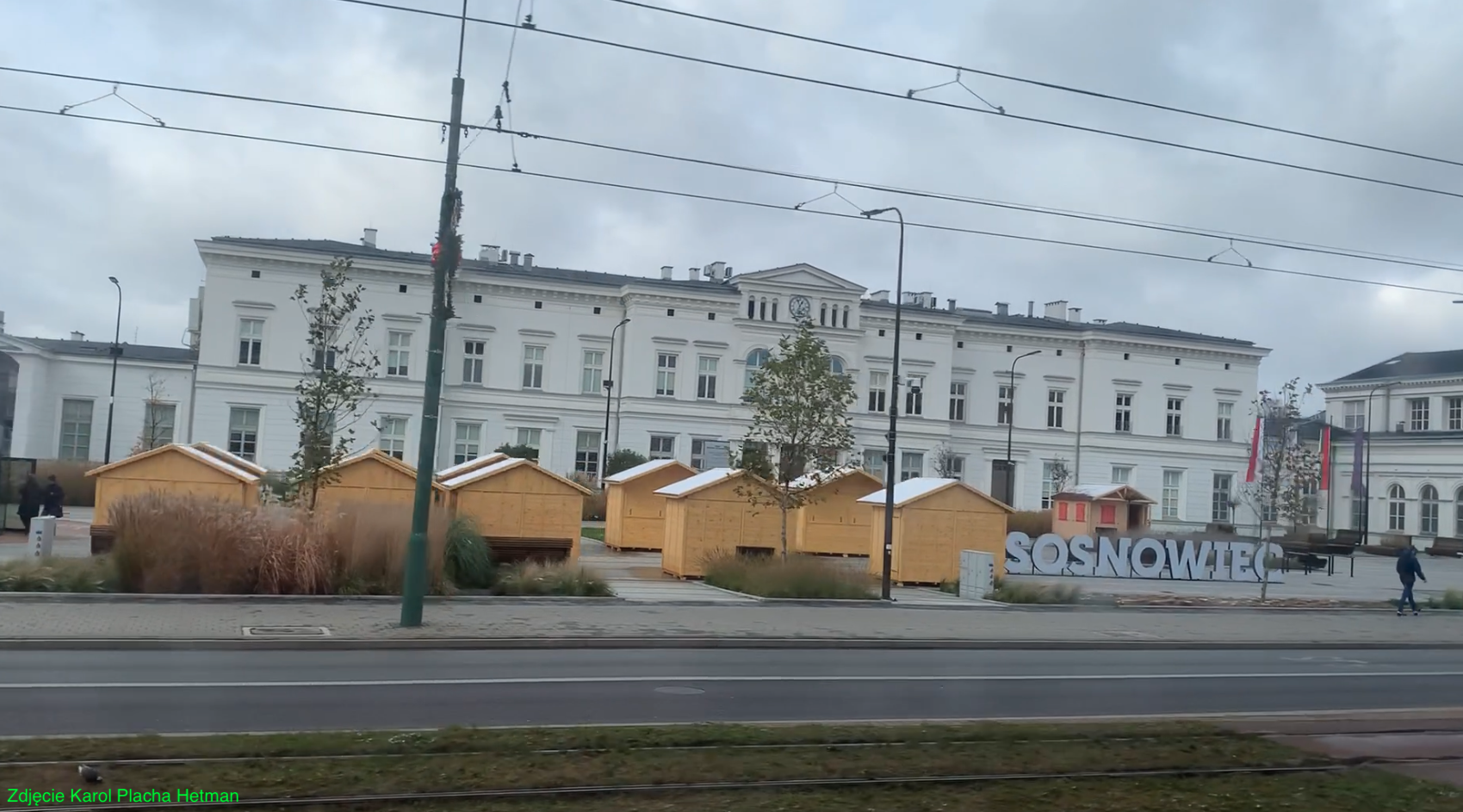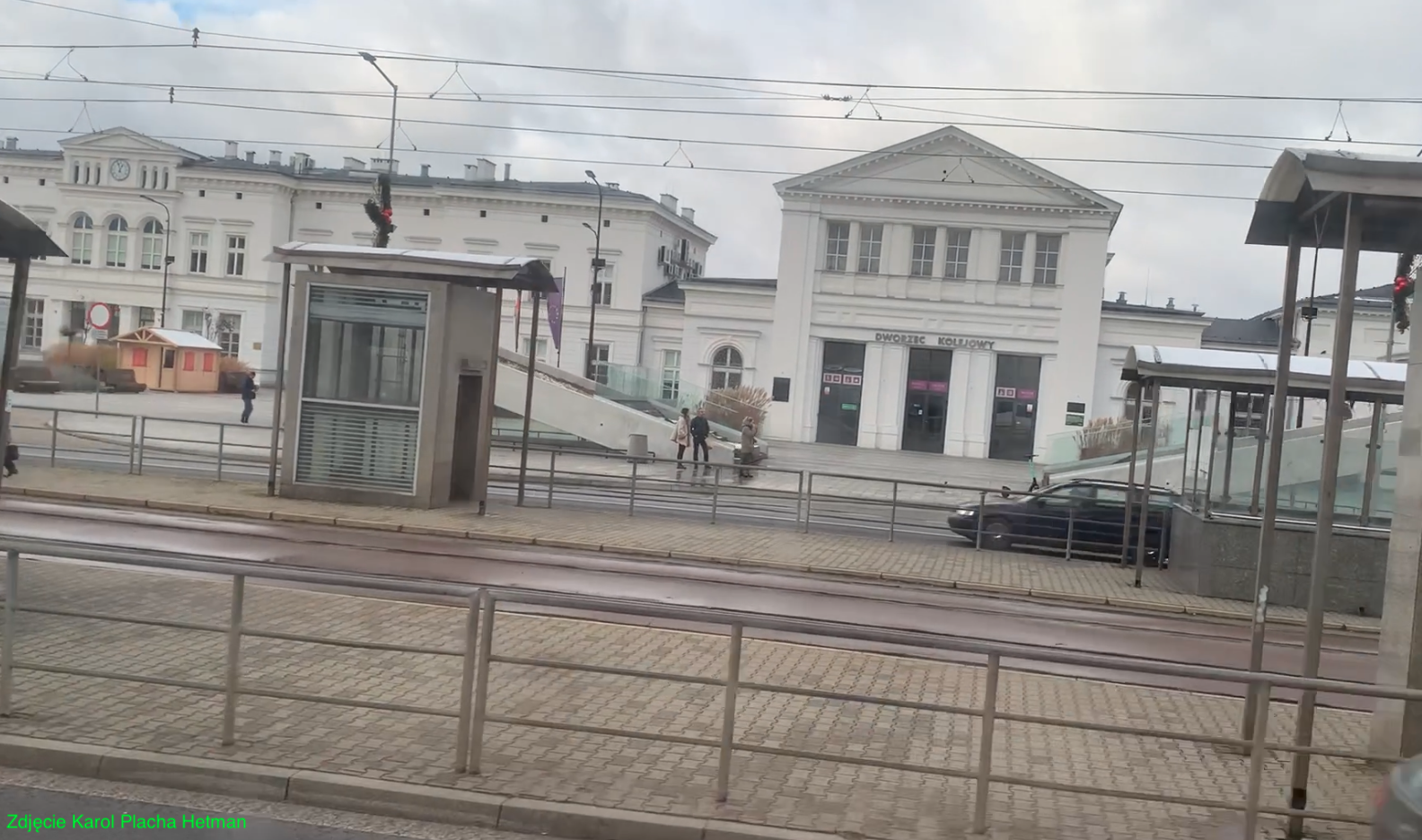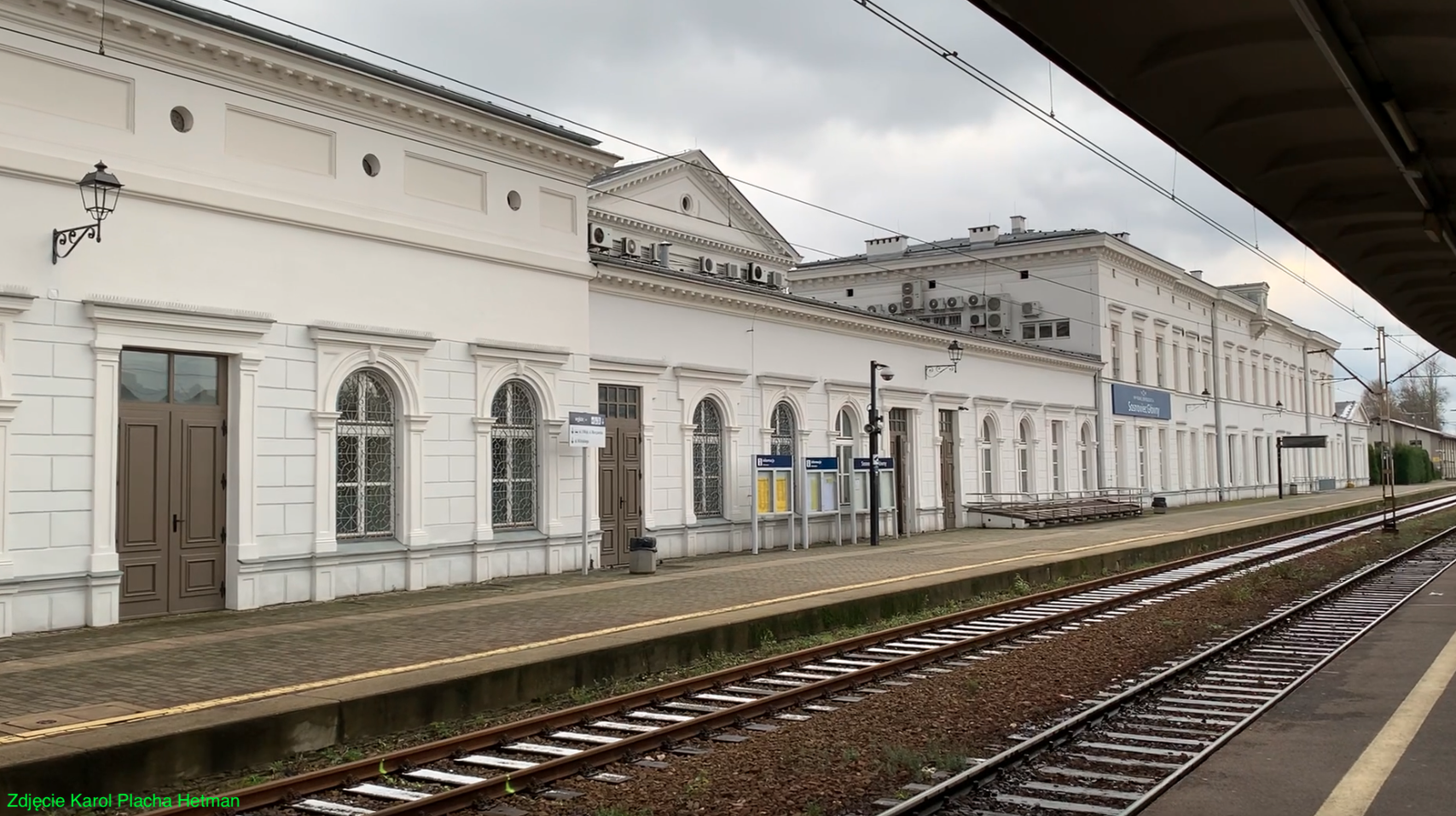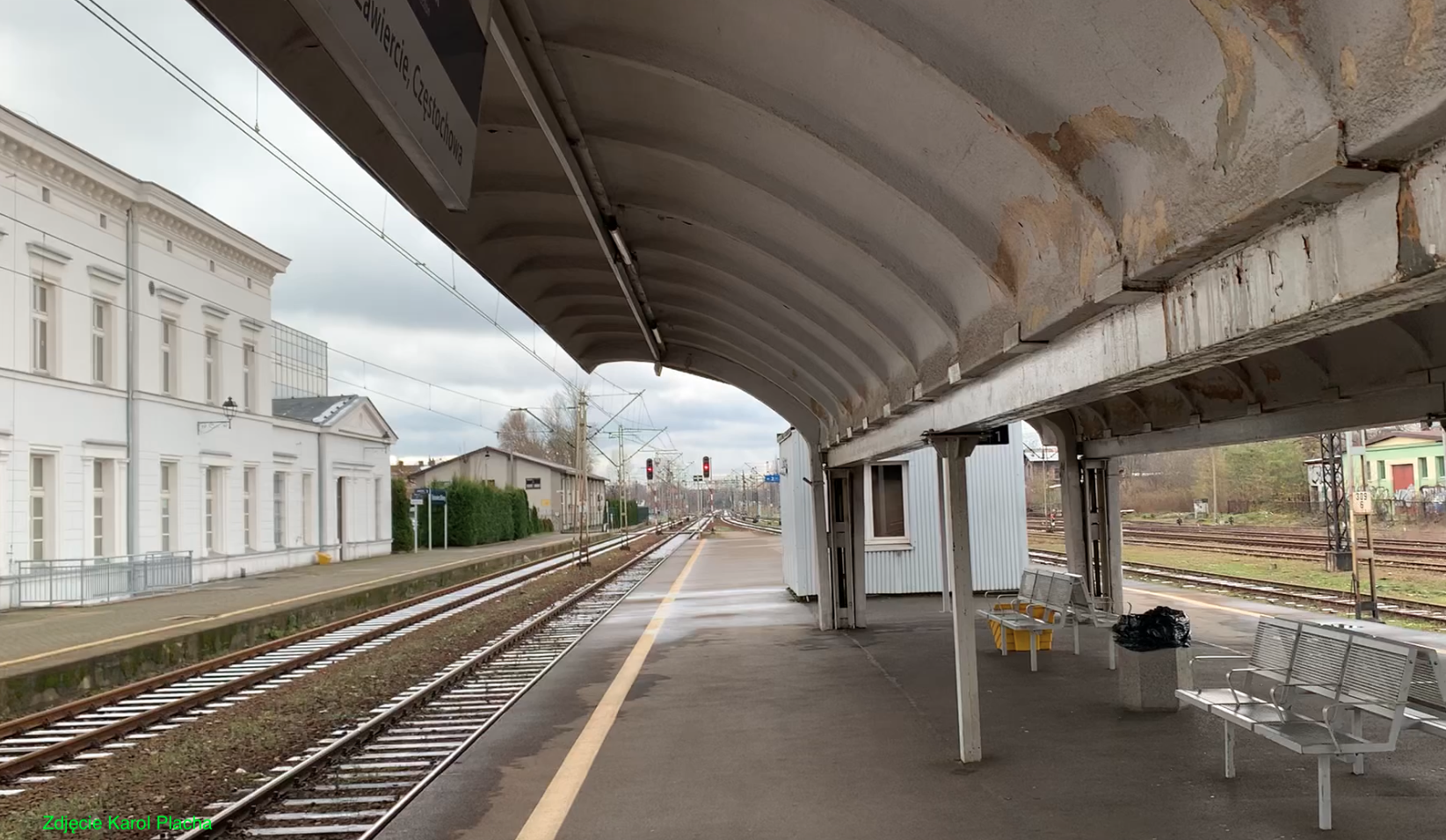Sosnowiec 2023-12-09
Sosnowiec Główny railway station.
Geographic coordinates: 50.279N 19.126E. Elevation 254 m.





City of Sosnowiec.
Sosnowiec is a city in Poland, in the Silesian Voivodeship. Historically, it is Małopolska, temporarily Zagłębie Dąbrowskie. The town received city rights on June 10, 1902. Sosnowiec is not Silesia. This is Polish Zagłębie Dąbrowskie. In broad terms, Zagłębie Dąbrowskie covers the area of modern communes: Sosnowiec, Będzin, Dąbrowa Górnicza, Czeladź, Wojkowice, Sławków, Psary, Bobrowniki, Ożarowice, Mierzęcice, Siewierz. The name Zagłębie Dąbrowskie consists of two parts. The basins were large pits in which there was hard coal under a small layer of earth. Dąbrowa is a deciduous forest or thickets with a predominance of deciduous trees, including oak.
The city of Sosnowiec has an area of 91.16 square kilometers. The city's population is 189,178 inhabitants (2022). Sosnowiec is the largest city in Zagłębie Dąbrowskie and operates as a district. The city is situated on the rivers: Czarna Przemsza, Biała Przemsza and Brynica. So, Sosnowiec is located in the Przemsza basin, a left-hand tributary of the upper Vistula, in the lower reaches of the Czarna Przemsza and Biała Przemsza. The Czarna Przemsza flows through the city center from north to south in a regulated and tightly enclosed riverbed.
The name of the city comes from the pine forests covering these areas, because these areas had mainly sandy soil, which was not very suitable for settlers. The original name of the city was Sosnowice. The city was created by combining several towns during their urbanization. The first mention of a village called Sosnowiec dates back to 1727. In the Middle Ages, there were several centers of lead, zinc and silver metallurgy and charcoal production here. This area was annexed to the Polish Crown in 1790.
After the third partition of the Polish-Lithuanian Commonwealth, the settlements constituting today's Sosnowiec were part of the Prussian partition, from 1807 they were in the Duchy of Warsaw, and in 1815 they were incorporated into the Kingdom of Poland (Moscow partition).
Greater interest in this area dates back to the first partition of the Republic of Poland. Initially, the invaders did not set specific borders. The partitioners established the first strict borders in 1846. They were forced by the dynamic development of the railway. The easiest way was to mark the borders along the rivers: Czarna Przemsza and Biała Przemsza. In this way, the so-called Three Emperors' Triangle, maliciously called the Three Emperors' Outhouse, was created. As a result, it was a convenient place for trade. The Prussians, later in Sosnowiec, began to open factories whose products were intended to be exported to their brothers in the Muscovite state and east towards Lviv and Kiev.
An example is the Prussian industrialist Heinrich Dietel, a producer of worsted wool and cloth, which he sent to Moscow for the Russian army. The palace and former buildings of Heinrich Dietel's textile factory are located in Sosnowiec, near the railway line. It is not true that Dietel's Prussian family did not support Hitler. The family escaped only at the beginning of 1945, when the Germans realized that the Red Wilderness was approaching. The whole family went to the USA.
Let us remember that in 1846, there was the Republic of Krakow, dependent on Vienna, but with its own local government and treasury, and there was the Kingdom of Poland, completely dependent on Moscow. During the January Uprising in 1863, Polish residents supported the uprising and took part in it. Polish administration, court and customs service were temporarily established. In 1898, a May Day march took place in Sosnowiec. In 1905, Sosnowiec joined the communist revolution and the Zagłębie Republic existed for a few weeks.
Around 1895, in the town of Maczki, at the railway station, an unsuccessful assassination attempt on the Tsar was planned. Poles took advantage of this fact positively; The Muscovites allowed the construction of a Catholic temple - in thanksgiving for saving the tsar.
The community of Sosnowiec had been striving for many years to obtain city rights, which was achieved only in 1902. Previously, there was a theater, libraries, primary and vocational schools, medical clinics and a press here. It was the first case in the Kingdom of Poland when the Muscovites granted city rights to a Polish city. The second city was Puławy, which was granted city rights by the Muscovites in 1906.
At the beginning of the 20th century, in Sosnowiec there were; 11 steelworks and factories, 10 brickyards, 2 hard coal mines, a power plant, 3 mills, 314 craft workshops, 238 shops, 4 hotels, 15 beer houses, 65 restaurants. There were 56 registered horse-drawn carriages at the residents' disposal. Administrative Sosnowiec expanded in 1914 and 1975.
After the Republic of Poland regained independence in 1918, the entire region became part of the Kielce Voivodeship (1919-1939). At the beginning of November 1918, workers disarmed the last Germanic military units. On November 11-12, 1918, the Council of Workers' Deputies of the Sosnowiec District was established. Not the only communist council in Zagłębie Dąbrowskie. Revolutionary, communist greetings were sent to Moscow. On July 21, 1919, the councils of delegates were liquidated and the communists were arrested.
In the period 1925-1929, a water supply and sewage network was built in Sosnowiec. Public transport was established, with electric trams.
The real development of Zagłębie Dąbrowskie dates back to 1920, when blast furnaces, open-hearth furnaces and rolling mills were launched. Marten is a gas-fired furnace in which steel is melted from steel scrap, while obtaining heat thanks to the appropriate setting of distribution valves. The steel industry was managed by the Society of Sosnowiec Pipe and Iron Factories. The main metallurgical plants included: Huta "Sosnowiec" (Sosnowiec), Huta zinc in Sosnowiec, Huta "Cedler" (Sosnowiec), Huta "Milowice" (Sosnowiec), Huta "Staszic" (Sosnowiec), Huta zinc "Paulina" in Zagórze , Huta zinc "Joanna", Huta Katarzyna, then Buczek, Sosnowiec (1881-2010), Walcownia "Emma" (Sosnowiec).
World War II was a period of bloody persecution of Poles by Germans. Sosnowiec was engulfed by a wave of displacement of Poles and other nationalities who were Polish citizens. Sosnowiec was incorporated into the paradise. From the very beginning, these were organized and not accidental activities. The first population migrations were associated with the escape of Poles, civilians, from areas affected by war. Then local authorities issued folkslists. Poles who did not sign the folkslist were sent to the General Government with only hand luggage. Many residents of Sosnowiec received displacement orders. Often, the local Germanic minority denounced Poles, especially those who had greater wealth. The Germanic army and police services had great freedom of action in the occupied territories. In Zagłębie it was said that there were other Germans involved in this than those from the Great World War. In a large area of western Małopolska, the Germans created a network of displacement camps called Polenlager, found nowhere else. These camps were intended for Poles who were imprisoned there with their entire families, indefinitely, without toilets, without kitchens, without new clothes. These were usually factory halls, devoid of machines. The Polish population who were not transported to the General Government were used for slave labor. This even applied to children from the age of 12. The attitude of Poles, education or profession did not matter. The "Pole" stamp already stigmatized the Polish population. The Germans from all over Silesia displaced over 81,000 Poles. Let's not forget that there were also mass executions. In Sosnowiec, most executions were carried out in 1941. Instead of the Polish population, Germanic people were brought from Romania, CCCP, the Baltic countries and from Paradise itself.
In Sosnowiec in 1937, the National Defense Battalion "Sosnowiec" was formed, which at the end of August 1939 was incorporated into the 201st Infantry Regiment of the 55th Infantry Division. The regiment fought in the September Campaign as part of the Kraków Army. In the first days of the war, the 23rd Accompanying Squadron was stationed at the field airport in Klimontów, near Sosnowiec. On September 4, 1939, Germanic troops entered the city of Sosnowiec. On January 27, 1945, the 59th Soviet Army entered the city. On April 6, 1945, the Ministry of Public Security (communist administration) established Central Labor Camps, among others, for former soldiers of the Home Army and the independence underground. Labor camp No. 140 was established in Sosnowiec.
After World War II, the development of Zagłębie Dąbrowskie and the entire Upper Silesia continued. Sosnowiec became a mining and metallurgical town. It was like this until 1989, when the communist camp collapsed. Most mining plants were gradually closed down. Poland's accession to the European collective farm intensified this process. The city was forced to transform into an industrial and commercial one. As a result, unemployment increased dramatically. In March 2015, the number of registered unemployed people in Sosnowiec was 9,900 inhabitants, which represented an unemployment rate of 13.5% for the professionally active.
In the second half of the 1990s, six hard coal mines operated in Sosnowiec. In 2005, only one mine was operational; KWK Kazimierz - Juliusz, which was not only the last mine in the city, but also in the entire Zagłębie Dąbrowskie. Around 2015, this mine was closed. In 2020, the city of Sosnowiec became the owner of plots of the former Kazimierz-Juliusz coal mine. The size of the plots is 2.8 hectares and their market value is PLN 3.7 million. Kazimierz-Juliusz was the last operating coal mine in Zagłębie. The area where the headquarters of the Kazimierz-Juliusz mine in Sosnowiec was located, together with the hoisting tower, became the property of the city of Sosnowiec. Let us remember that hard coal mines in Poland were not closed due to the exhaustion of raw material deposits, but under the dictate of the European-Germanic kolkhoz.
On June 14, 1999, Pope Saint John Paul II the Great visited Sosnowiec during his pilgrimage to his homeland, meeting with the faithful in the square at Gwiezdna Street.
On the night of October 28-29, 2014, a fire broke out at the Cathedral in Sosnowiec. As a result, the roof of the temple burned down. The temple was rebuilt.
Railway transport.
The large area of Sosnowiec means that there are as many as 7 railway stations in the city. Historically, it is one of the first railway junctions in the Republic of Poland. On April 1, 1848, the Warsaw-Vienna Railway reached the Granica (Maczki) station. In 1887, the Iwangorodzko-Dąbrowska Railway, i.e. Dęblin - Dąbrowa, was connected to the Sosnowiec (Główny) station. Both stations were border stations until the Great War.
Currently (2023), the stations in Sosnowiec are located on the railway lines: No. 1 (Warszawa Centralna - Katowice): Sosnowiec Główny station. No. 62 (Tunel - Sosnowiec Główny): Sosnowiec Południowy, Sosnowiec Dańdówka, Sosnowiec Porąbka, Sosnowiec Kazimierz stations. No. 133 (Dąbrowa Górnicza Ząbkowice – Kraków Główny): Sosnowiec Maczki station. No. 134 (Mysłowice – Jaworzno Szczakowa): Sosnowiec Jęzor station.
In the neighboring Sławków, 22 km away from the center of Sosnowiec, there is a large dry transshipment port "Euroterminal", which is at the end of the Broad Gauge Metallurgical Line, towards Ukraine.
Independently of the PKP railway, there is a network of Kolej Piaskowa, the former company of Przedsiębiorstwo Materialów Podsadzcznych Przemysłu Węglowego. This railway connected and continues to connect backfill sand extraction sites with hard coal mines. As a result of the liquidation of many hard coal mines, part of the network has been closed down, and parts of the network are increasingly being used to transport other goods.
Sosnowiec Główny railway station.
The railway station in Sosnowiec was opened on August 24, 1859. In the period 1859-1900, the station was called Sosnowice. Since 1901, the name Sosnowiec. The station was entered on the list of monuments under number A/15/99 on April 30, 1999.
The Sosnowiec Główny station is located in the infrastructure center of the city of Sosnowiec, at 3 Maja 16 Street. According to the PKP classification, the station has the highest Premium category.
The station was built on the railway line that connected the Warsaw-Vienna Railway and the Upper Silesian Railway. This connection created a direct connection between the Muscovite state and the Prussians. Until then, the connection was carried out through the Austro-Hungarian partition and the Granica (Maczki) station and further to Mysłowice. As a result of the agreement between the railway companies in June 1858, the construction of the Ząbkowice - Sosnowiec - Szopienice connection began. On August 24, 1859, the Ząbkowice - Katowice connection was officially opened. As a result, most of the freight and passenger traffic between Muscovites and Prussians began to bypass the Granica (Maczki) station. Already in 1868, 25 times more goods and three times more passengers passed through Sosnowiec than through the Granica station. Sosnowiec (Sosnowice) station was a border station. Transhipment facilities, storage yards, warehouses and a customs house were built here.
The station building was built in the neoclassical style. It is a two-story building with ground-floor wings. The station's designer was probably the Italian architect Henryk Marconi. The building is similar to the Vienna Station in Warsaw. The station building houses: ticket and baggage counters, a passport office, waiting rooms for 1st, 2nd and 3rd Class passengers, rooms for the families of nobles, a restaurant, a customs expedition and apartments for the restaurateur and station professionals. Two platforms with wooden floors, numerous sidings, storage yards, warehouse buildings, workshop rooms and a rectangular locomotive shed were built.
Around the station were built; inns, lodging rooms, shops, service establishments. Apartment blocks were built for railway workers. New sidings were built to local plants and newly opened hard coal mines and steelworks.
In 1922, a connector between the Sosnowiec Główny and Sosnowiec Południowy stations was put into operation, thanks to which the main station in Sosnowiec became a railway junction. In 1927, wagon repair workshops were established next to the rectangular locomotive shed. In 1929, a new fan-type locomotive shed was built, equipped with a turntable.
In the 1950s, the electrification of Zagłębie Dąbrowskie began. The decision to electrify the Warsaw - Sosnowiec - Katowice line was made in 1948. More and more trains were operated by electric locomotives. Mainly freight trains that transported hard coal. Electrification took place in stages, of which the Gliwice - Katowice - Sosnowiec Główny - Łazy section was electrified on June 1, 1957.
At the end of the 1960s, the reconstruction of the Sosnowiec Główny station began to adapt it to changing needs. In the north-eastern part of the station, several old buildings were demolished. Among them was a gymnasium. A large building was built on this site; Railway Center for Calculating Machines, and currently the Railway Information Technology Computing Center of PKP, or more precisely PKP Informatyka.
At the end of the 1960s, the station was renovated. New installations were made; electricity, water and sewage. The woodwork and floors were replaced. A new flap, dynamic railway information was installed. In the main hall, an entrance to the underground passenger tunnel was built, which was extended on the north-west side, up to Jana Kilińskiego Street.
In the period 1997-2002, the station was modernized again. It was related to the celebration of the 100th anniversary of the city of Sosnowiec. As part of the work, the city center was rebuilt. The station has been renovated inside and out. The facade of the station on the side of the station square and on the side of the tracks has been renovated. Another renovation was carried out in the station tunnel, which was extended in the east to Warszawska Street, creating a route to the Old Town. Now the tunnel has become a commercial and service passenger.
In 2014-2015, a major renovation of Platform 1 and 2 was carried out. The shelter on Platform 2 was repaired and painted. A new surface was made and new edge slabs were laid. Platform 1 is a single-edge, low platform, 230 m long and 30 cm high. Track No. 4 of railway line No. 62 runs next to it. It has a hardened surface made of cobblestones. Platform 2, on the other hand, is an island platform, high, 395 m long and 65 cm high. Next to it there are the tracks of railway line No. 1, from the north track No. 1, from the south track No. 2. It has a bituminous surface. This platform is equipped with a roof and benches. There are still flap-type railway information boards on the platforms and at the station.
On May 7, 2015, the main hall of the station, which had been closed to travelers during the rule of the Freemasons (2008), was reopened to travelers. Three PKP InterCity ticket offices have been reopened in the hall. Rooms have been adapted for the station's security service, which operates 24 hours a day, 7 days a week. Elevators have been installed for disabled passengers, with large luggage and bicycles. In the underground part of the station there is a ticket office for the Silesian Railways and a waiting room. The cost of the work amounted to PLN 1 million.
Railway lines Sosnowiec Główny.
Railway line No. 1: Warszawa Zachodnia – Katowice. The Sosnowiec Główny station is located on km 309.544 of the railway line. Railway line No. 1 is electrified, almost entirely double-track, with a length of 316,066 km. In the period 1845-1847, the Warszawa Zachodnia - Dąbrowa Górnicza Ząbkowice section was opened, and in 1859, the Dąbrowa Górnicza Ząbkowice - Katowice section was opened. The line was electrified in the following periods: 1937 (only within the borders of Warsaw), 1953-1957, and completed in 1967. The maximum speed of the train is 160 km/h.
Railway line No. 62 Tunnel - Sosnowiec Główny. It is a railway line on the border of the Silesian and Lesser Poland Voivodeships. It is the final section of the historic Ivangorod-Dąbrowska Railway. The line runs east to west. The line is 84.347 km long, and the Sosnowiec Główny station is located at the end of this line. The line is double-track almost along its entire length. It is electrified with a voltage of 3 kV DC. The maximum speed of trains is 120 km/h.
Passenger train traffic.
Due to its location on one of the busiest railway lines in Poland, Sosnowiec Główny station is an important railway communication point. Carrier trains stop here; Koleje Śląskie (established in 2008) and InterCity. Two regional lines of the Silesian Railways run through the station: S1 Częstochowa - Gliwice and S4 (S41) Sosnowiec Główny - Tychy Lodowisko through Katowice. Long-distance trains stop at the station: Your Lines of Railways, InterCity, Express InterCity, Express InterCity Premium and international trains. In December 2023, 77 long-distance trains departed from the station. The most important connections: Warsaw, Gdynia, Gdańsk, Dęblin, Lublin, Prague (Czech Republic), Białystok, Katowice, Vienna (Austria), Świnoujście, Szczecin, Bielsko Biała, Budapest-Keleti (Hungary), Wrocław, Olsztyn, Łódź Kaliska, Kielce, Ostrava (Czech Republic), Hel, Gliwice. In addition, 55 regional trains departed; Katowice, Gliwice, Tychy, Częstochowa, Katowice Airport (Mierzęcice - Pyrzowice).
Sosnowiec Główny station data.
The Sosnowiec Główny station is located in the city center, directly at 3 Maja Street, near the streets; Jan Kiliński, Warszawska and Bartosz Głowacki. In the immediate vicinity there is Modrzejewska Street, which is a promenade and the main shopping street in the center of Sosnowiec.
In the immediate vicinity of the station there are 5 public transport stops: Bus lines No. 26, 35, 55, 88, 91, 100, 106, 150, 160, 188, 299, 690, 723, 808, 811, 813, 815, 902, 908, 935. Tram lines No. 15, 21, 24, 26, 27. Near the station there is a paid parking lot for passenger cars, which has only 100 parking spaces. There is a TAXI rank directly next to the right wing of the station building, from Warszawska Street. There is no luggage storage at the station. Toilets are paid in the underground tunnel. Free WI-FI internet access available in the station lobby.
TY51-133 steam locomotive.
A monument of technology - the TY51-133 steam locomotive stands on the premises of the high school complex, at Jana Kilińskiego Street.
Written by Karol Placha Hetman
